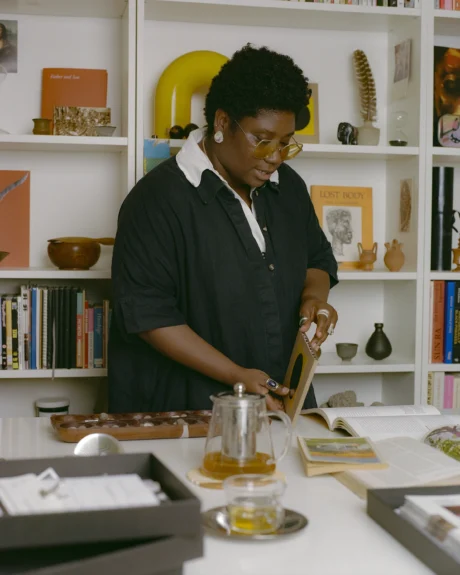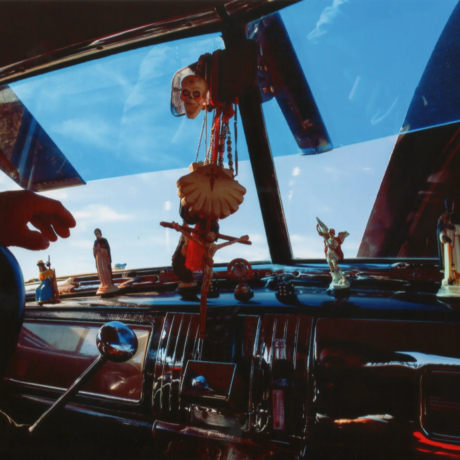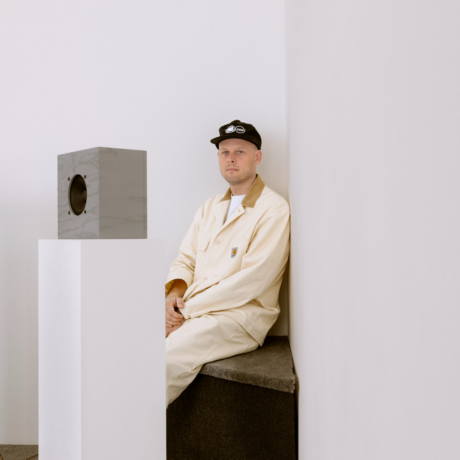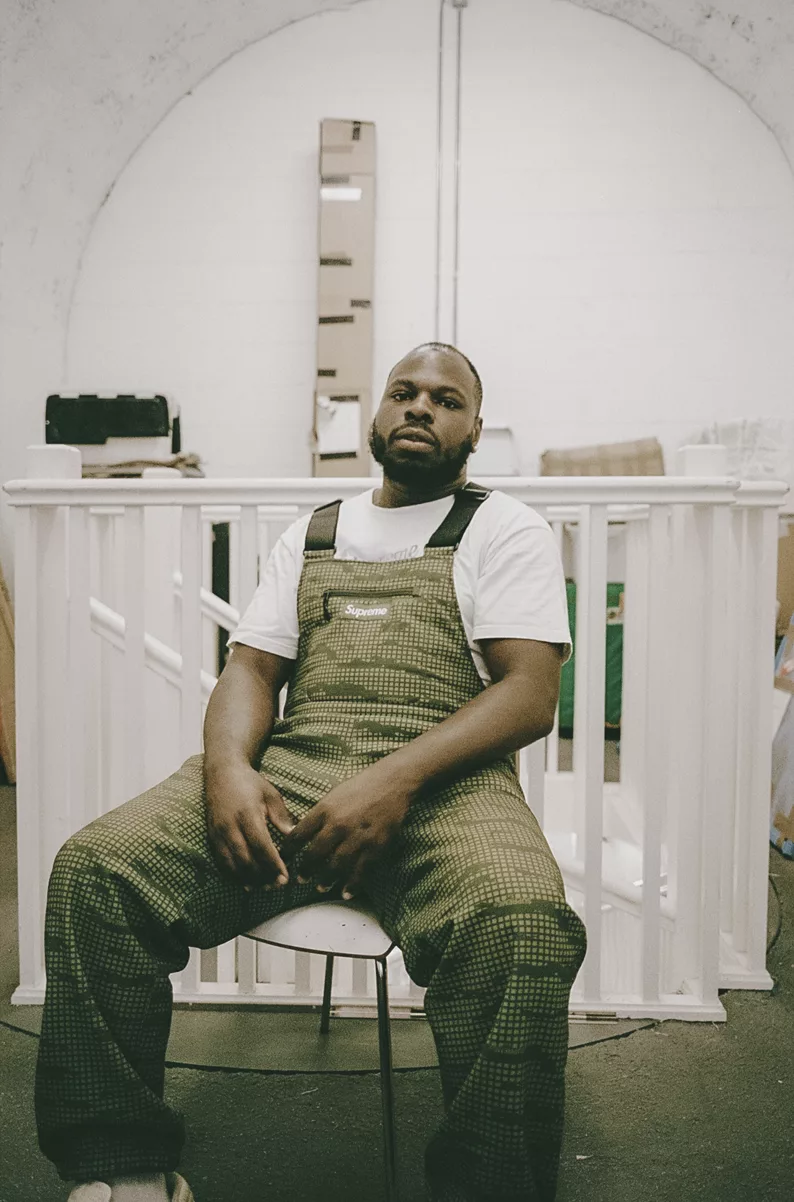
RIP Germain is a multidisciplinary conceptual artist based in South-East London. His practice navigates a complex balance between celebrating and interrogating forms of Black Culture and history, drawing on contemporary music, jewellery making and archiving personal, collective and cultural moments. Toward the end of summer, we sat in a park in South-East London overlooking the city skyline to discuss his practice, UK Drill and ways of remembering the past in order to reclaim the future.
Those who visited RIP Germain’s show in May 2023 at the ICA, Jesus Died For Us, We Will Die For Dudas, will remember a Caucasian Tupac Jesus piece necklace encased in a glass cabinet in the show’s final room, accompanied by a collection of diamond-adorned jewellery made by A-Jewellers, situated in London’s Hatton Garden district.
The work, titled White Makaveli Mod (Jesus Piece) (Strictly For My N.I.G.G.A.Z) is constructed of a white gold pendant, chocolate and champagne diamonds, rubies and sapphires. It is just back from completion, having had the final chain fitted, whereas the version in the show had a chain lent by the Hatton Garden firm. RIP Germain shuffles a black box from inside a duffel bag and displays the work, which sparkles blindingly in the afternoon sun, a piece of immeasurable complexity and nuance.
Explaining his desire to explore jewellery making within his practice, he tells me ‘the jewellery industry in the UK is very fresh and new. It’s only through UK Drill that the UK Rap world has had an actual industry behind it, coming through the lineage of Grime, Garage and even Jungle. Those previous genres had superstars, Jungle had Goldie and maybe a Guy Called Gerald with Finley’s Rainbow. With Garage, you had your So Solid Crew. You had Dizzee, Wiley, Stormzy, and Skepta, but they all came one after the other rather than all at once.
‘The thing was, it wasn’t reinforced. If the artist’s careers were to take a downswing, there isn’t an amass of artists to come through and establish careers. It’s through the C and D-level artists that a genre thrives and delivers a self-sustaining industry. In UK Drill, you now have artists making enough money to live off it and focus on the music, artists such as Digga D, Loski, Heady One, H, RV, Tion Wayne. It’s also not just relegated to London anymore as well; it’s become an industry which is self-supported’.
Looking towards the future once one has acknowledged the past was a motivation for RIP Germain to start exploring jewellery making within his practice. Engaging with an aspect of culture that many within and outside of the culture don’t readily have financial access to, RIP Germaine was able to peer behind the curtain of this coveted industry, a proposition that allowed him to view the societal structures that read him in a certain way, presenting this experience back to the world for others to navigate within his installation-based work.

‘Black culture is seen by people as being monolithic. Society treats Black people as their own cultural navigators, in the sense that Black people know everything about Black culture and have expertise on it, which is ridiculous’.
RIP Germain’s knowledge of the Jesus piece lineage in Hip Hop put him in decent stead to navigate this realm, however. ‘I know that Ghostface Killah was the first person to get a Jesus piece made, I know Notorious B.I.G was the first person to popularise it, Big Pun was the one to get different versions of it, Slick Rick got the truck jewellery. I can talk about it, but I couldn’t previously experience it in a meaningful way until now’.
RIP Germain found he was able to work transparently with the makers; navigating the parameters that came with this exclusive, sometimes coveted, mode of production. He notes how the artwork didn’t arrive on time. The work contains brown diamonds, the least popular kind, which therefore took a month to source. He found himself on video calls at a convention in India, where sellers held up bags of diamonds for him to choose from. Tupac didn’t come back fully Caucasian, as he had specified it should to the jeweller based in New Jersey. Presumably, through it is because of the personal ethics of the maker that piece arrived with more of a bronze complexion.
The ICA show that first displayed the work presented an immersive, multipart installation that examined ‘the complex logic of cultural gatekeeping within Black culture, and the (mis)perception of these dynamics in a wider (white) world’. In the gallery downstairs was a convenience store which acted as a false front, doubling up as a drug depot. The outer front was spraypainted with lettering that read ‘deja vu’ (Cambridge Dictionary: the strange feeling that you have already experienced what is happening now). Inside, visitors discovered a marijuana grow, leading to writers and critics speculating on its authenticity, as they would later do with the encased jewellery in the upper room, enclosed behind a false Hatton Garden front.
Architecturally folded into spaces of commerce and commodity, visitors navigated these spaces commonly associated with stereotypical Black identity. By showcasing two different worlds that share familiar mechanics, the audience enacted roles as curious cultural outsiders into realms usually reserved for only a select few.
Growing up in Luton, RIP Germain explains how his exposure to creative worlds was self-led by consuming aspects of popular culture, rather than being informed by institutions and galleries, of which there were none in his city. He tells me ‘There wasn’t that much knowledge distribution toward me. It was mainly through media such as films, graphic design, comic books, and manga’.
Entrances to visual culture were gleaned by his early exposure to music and its rich generational lineage. He recalls ‘when I was a toddler, my parents listened to Dance Hall and Ragga. My older cousins later played me Jungle and early mid-90s Hip Hop. I engaged with the embers of Garage and the beginning of Grime. That’s the first scene I was first involved in that was extremely important to me’.
Discussing the early years of Hip Hop, RIP Germain tells me that Raekwon’s Only Built 4 Cuban Linx was a ‘structure breaker, the first album where artists took on different aliases. Even the visual presentation of it is known as the ‘purple tape’. Raekwon grew up shotting and the way you’d distinguish yourself from all the other drug dealers was by having a different coloured pot. He’s shotting his music. Those types of creative ideas inspire me to take a different approach.’
The intricacies and sonic allusions within music have had a clear impact on the artist’s practice, an ongoing process which defies definition by proliferating itself into reference points and codified meanings at every turn. Reviews of his ICA show afforded a sense of disorientation within the multitudinous aspect of the work, forgoing a complete critical or analytical understanding. Writers permeated his work by simply drifting, grasping onto what they could glean from broad themes.
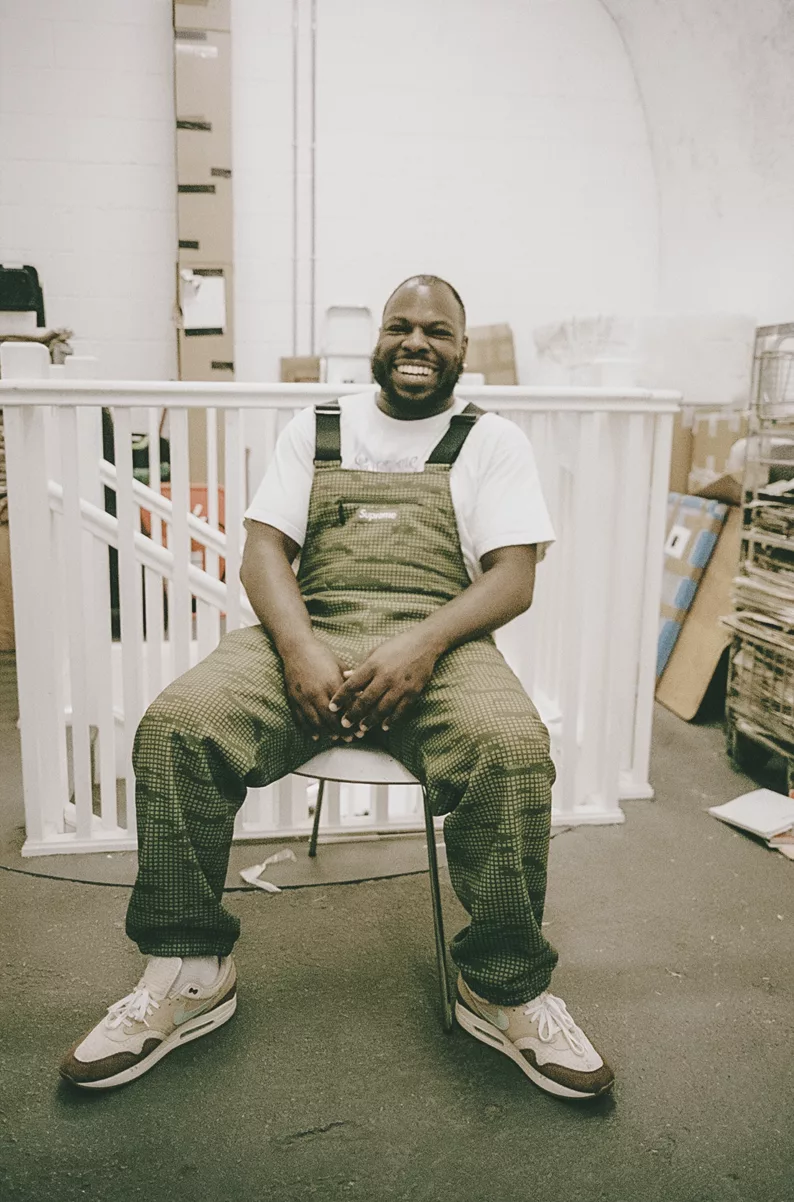
Knowledge of Black music history is perhaps the most useful, but by no means ubiquitous tool when exploring RIP Germain’s work. Individuals will bring their own reference points, opening vaults that others may glance over. Some lead to shifting levels, mirrors and doors. References one might consider are the Amen break, one of the most well-known samples in modern popular music, which opened new sonic vistas for generations of artists, exploding into multiple genres.
‘It’s the same with Grime’, he tells me. ‘The lack of equipment that they had at their disposal and how they maximised the resources they had. Out of this shitty equipment, they created literal sonic gold and built industries out of it. I don’t even understand how they made music like the Grime Bootlegs. If you’ve ever listened to a Flippy Smallz bootleg with Crazy Titch and Boyz in da Hood, you realise that it doesn’t make sense how it sounds so good.’
Rather than the music as a finished product, it is the aspect of bricolage and utilitarian method of pushing resources into new worlds that holds sway for the artist. ‘Grime artists hated bootlegs. But I love that renegade aspect of it. When it comes to music in a contemporary sense, you have UK Drill, which is where my practice is referencing to various degrees.’
RIP Germain sees one aspect of his role as an artist as a self-elected archivist of music subcultures. More than any other creative outlet of contemporary culture, Black music is the most vulnerable to subjugation by censorship and whitewashing. Rock’ n Roll history is overshadowed by Elvis, rather than giving credence to forebearers such as Little Richard and Chuck Berry. Disco and Techno have infamously been eclipsed by its contemporary association with white, London electronic scenes such as House.
The artist has an extensive catalogue of UK Drill music videos he’s been downloading onto his laptop from the internet since 2016. ‘Once upon a time, I thought things would be there forever because they are on the internet. But they can be erased’ he tells me. Preserving these music videos is a way of remembering through active documentation in the fragility of digital space.
He states ‘You don’t see the active participants documenting their own experiences in the current moment. You never had the Jungle scene writing a collective diary about their experiences as they were happening. They were too busy living it.’ If the purpose of art is to act as a collective memory of society, it is the role of the artist to become a mirror, reflecting culture on itself within the present moment, preserving culture which it is more fragile than it first appears, delicate when it seems in impenetrable.
‘Over the past couple of years, you’ve seen UK Drill videos get taken to points that P Diddy and Mase wouldn’t have even dreamt of making with Hype Williams in 1997’, Germain explains. ‘You have an artist from Peckham like Kwengface; he’s gone from the yellow brick road to rapping inside a glacier and in front of the Northern lights in Iceland. M1llionz, who is from Birmingham, has gone all the way to South Africa to shoot a video where he’s ritually blessed by a tribe in a jungle. Booter B from Huddersfield went to Kurdistan and had the Kurdish army act as his security with all these jewels displayed.
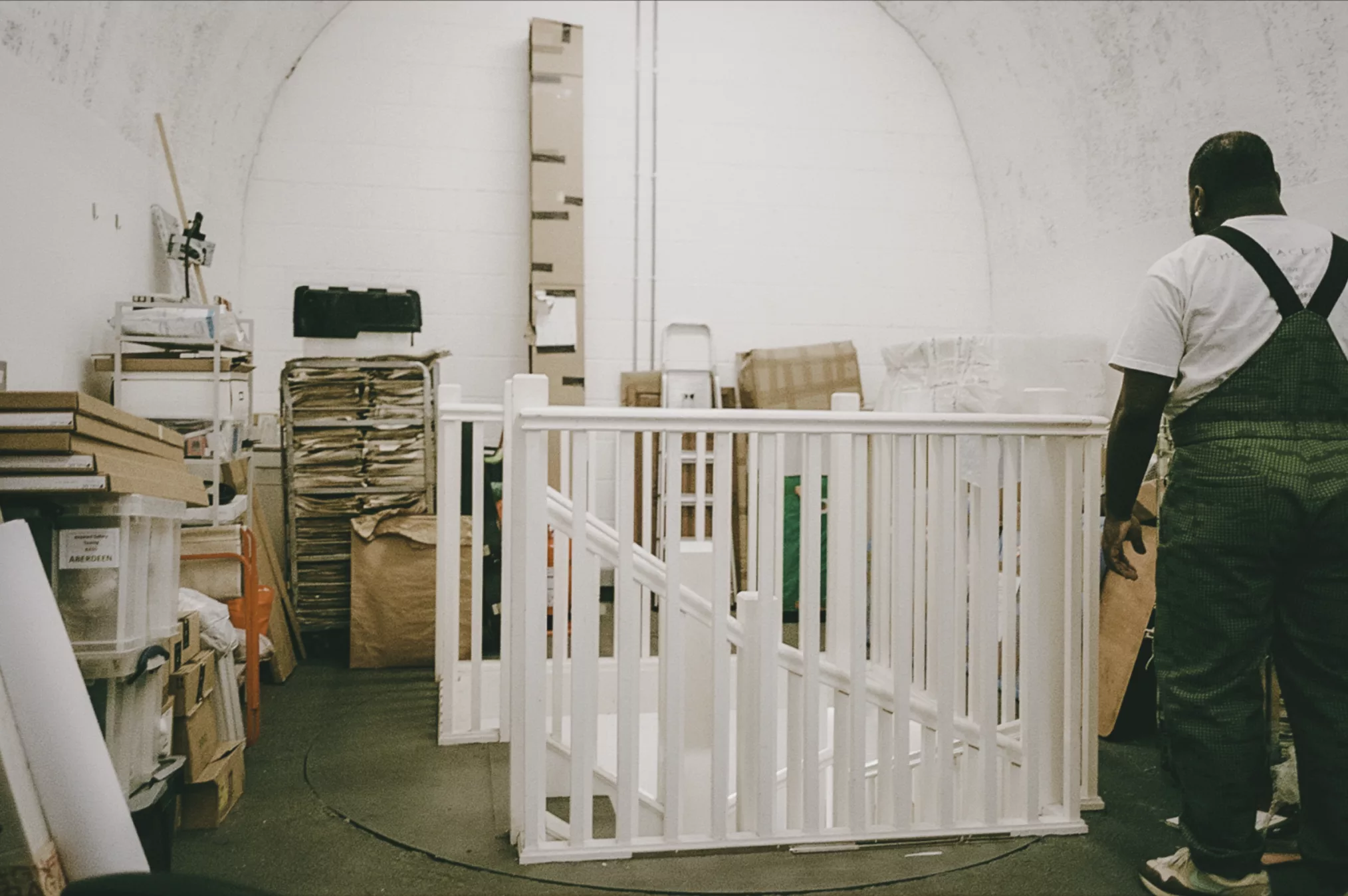
Germain sees this moment as a tipping point in UK rap, a cause of celebration where the UK stops playing second fiddle to its American counterparts. But he also urges us to treat the contemporary output with caution. As well as being often hyperviolent, Drill music videos can also be instructional, as with one of Manchester rapper Tunde’s films in which he teaches you how to bypass airport sniffer dogs whilst smuggling cocaine.
As the line gets pushed to new levels, crossing the threshold becomes increasingly dangerous, the nuance blurred by impact of what young people are bearing witness to. Interrogating the visual representation of music is a key component of Germaine’s practice. He acknowledges this tension and complexity by stating ‘it’s reductive to believe there’s solely a goodness or solely a badness involved. Lives had been saved by it that would otherwise have been lost by to the prison system, drugs or the cemetery.’
In RIP Germain’s show, Gidi Up, presented at Peak in 2018, he explored the tension and responsibility that both artists and listeners bear within the realm of hyperviolence in Drill music. In the video work, Tyson, a video screen presented viewers with Drill lyrics in a karaoke format, inviting visitors to sing along, interrogating the notion of at what point audiences become complicit participants in these worlds.
The Tupac Jesus piece glitters in the late summer sun. RIP Germain sees this work as emblematic of his practice in the present moment, which he has taken four and half years to arrive at. The crux of the piece is a cautionary expression of what could happen if Black communities don’t take ownership and control of their culture, or if history fails to remember genres such as Hip Hop as originating in the South Bronx, innovated by Black musicians who were able to take music to exceptional new levels.
RIP Germaine highlights the point by telling me about a pre-meme image that once passed around online spaces, describing the perfect Black man. It depicted Tupac in a business suit. ‘It covers all bases’, he tells me. ‘Tupac was a handsome man, very charismatic, very charming, but righteous as fuck and stood on his principles to his death. He was all for Black love, exploring Black Panther lineage. But the business suit implies he can function in the Western World and thrive.’

‘When I did my version of White Tupac in a business suit at the ICA show, it’s talking about the end game for Black culture within Western society. That is the kind of way Black culture gets synthesised. The most recent example is in UK Drill where it starts as a rivalry between Sticks in Angel Town and LD Scribz and 67 in Brixton Hill then it gets synthesized to Aitch’.
‘That is where the idea of the pendant comes from, by asking what the endgame of Black culture in this world is. It is a warning through visual mechanics. You need something harsh to slap you in the face to wake you up, not to gently massage you. This is what’s going to happen to UK Drill or whatever form of Black culture to come in the next ten or twenty years if the cycle keeps continuing and people aren’t learning.’
‘It’s a struggle to be a Black artist, making work you want to put out there. I’ve had conversations with young Black artists that have said they aren’t making the work they want to make in an ideal world because they don’t want to put themselves in spaces where their work is warped and ultimately treated in a negative way’.
As RIP Germain moves into the future, his work urges the reclaiming of narratives that allow for an autonomy of the present moment as cultures move into the future, written by history end epochs. In double entendre atypical of the artist work, which defies any sense of one-dimensional definition, RIP Germain is also engaged in a personal level on letting go of his work into the wider sphere.
‘An artwork lives three lives. The first is making it and presenting it. The second is when the audience is presented with it. The third is if someone buys it. What I’m learning now is to give freedom to the audiences, for it can go in any direction’.
Words by Andrew Finch
